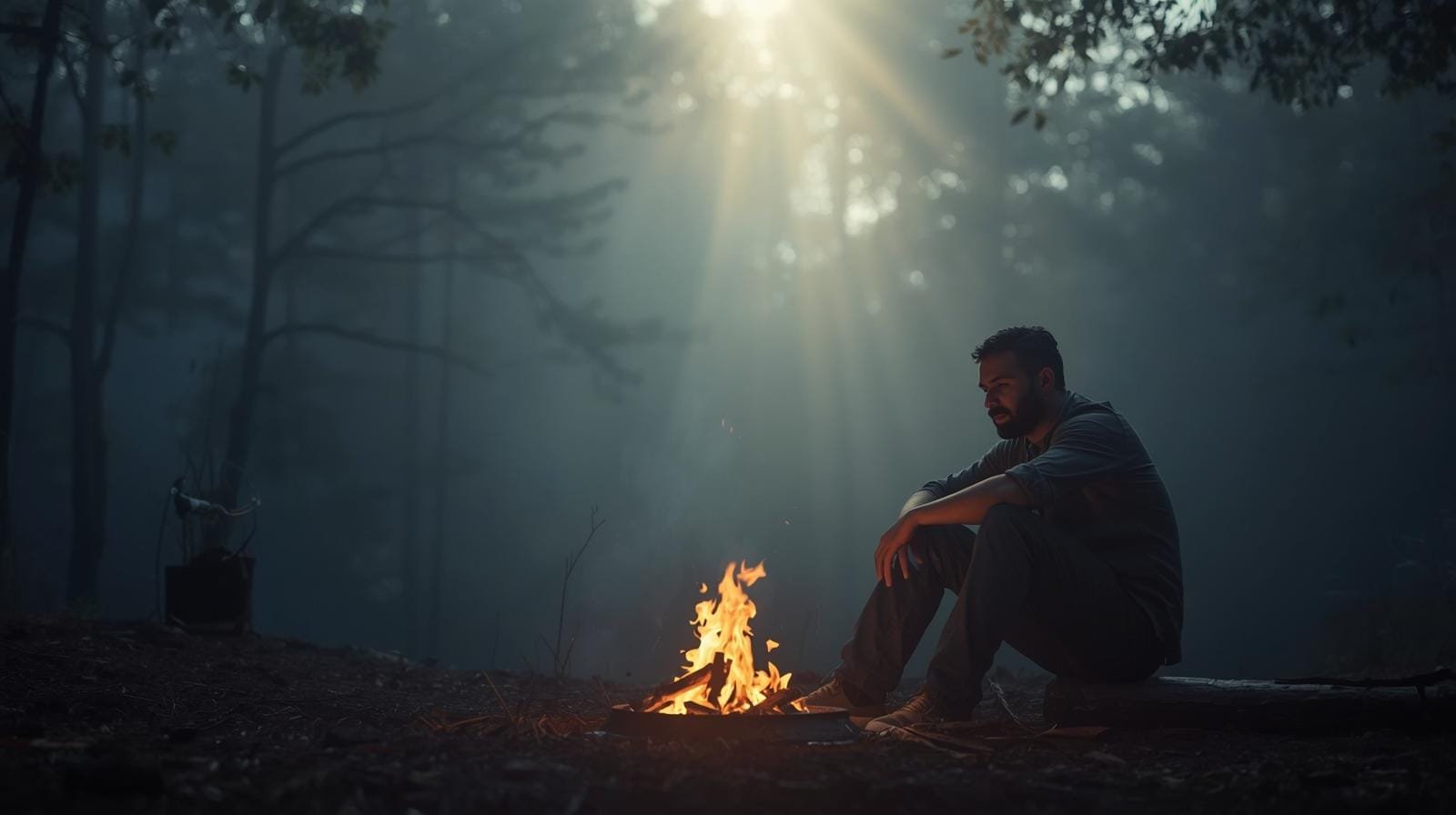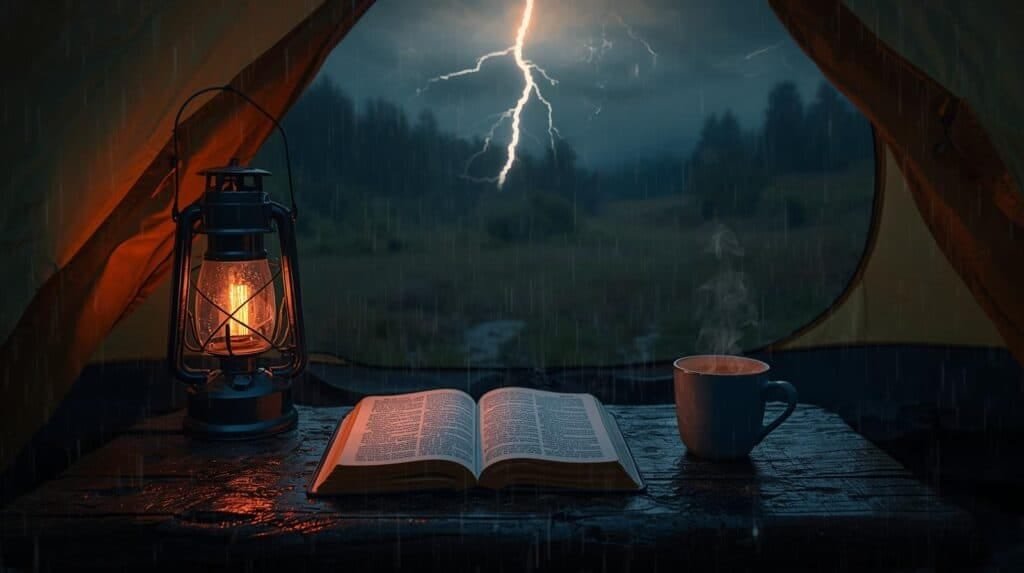
Strength in Stillness: Finding Peace Amid Chaos
Anchor Verse:
“Do not be anxious about anything, but in every situation, by prayer and petition, with thanksgiving, present your requests to God. And the peace of God, which transcends all understanding, will guard your hearts and your minds in Christ Jesus.”
— Philippians 4:6–7
Calm Is a Weapon
The storm isn’t always outside. Sometimes it’s in your head—pounding like a generator that won’t shut off. Bills stack up, headlines scream, and your to-do list looks like a tactical op plan gone sideways. Most people panic. Preppers plan. But even the best-stocked bunker means nothing if you lose your head when it counts.
Your greatest asset in chaos isn’t your bug-out bag or your food stockpile. It’s your ability to stay calm when everyone else is losing their minds. Peace isn’t weakness—it’s spiritual situational awareness. This is what strength in stillness really means.
That’s the kind of strength Philippians 4:6–7 describes: peace that guards your heart and mind like a watchtower. In a world addicted to anxiety, learning to find peace is the ultimate survival skill. According to the American Psychological Association, chronic stress affects nearly 75% of adults, making stress management techniques more critical than ever.
What Is “Strength in Stillness”?
Stillness isn’t about escaping the noise. It’s about quieting the inner storm long enough to hear the right signal. Strength in stillness is a discipline that separates those who survive from those who thrive.
Strength in stillness means:
- Calm under fire — You don’t freeze; you breathe and assess.
- Faith over fear — You trust God’s plan even when the map looks blank.
- Clarity under pressure — You stop reacting and start responding with purpose.
In tactical terms, stillness is that split-second pause before action—the moment where decisions go from sloppy to strategic. In spiritual terms, it’s when you stop trying to control everything and let God do His job. Research from Harvard Medical School shows that mindfulness and meditation practices can significantly reduce anxiety and improve emotional regulation.
Why Stillness Is Non-Negotiable
Panic Makes You Blind
Last summer, a buddy of mine got separated from his hiking group in a storm. Cell service was gone, visibility was zero, and his gut said run. Instead, he sat down. Not because he gave up—because he knew panic would get him killed. He tapped into his strength in stillness.
He took ten breaths. Checked his compass. Noticed a ridgeline he’d missed in his panic spiral. Walked toward it and found the trail marker fifteen minutes later.
Your brain craves certainty in chaos. When it doesn’t get it, cortisol floods your system and narrows your focus until you miss obvious solutions. The Mayo Clinic explains how stress hormones impair decision-making and cognitive function. That’s how smart people make catastrophically dumb decisions.
Stillness resets your mind. When you slow your breathing, you widen your awareness. You start seeing options again—like stepping back from the map to see the whole terrain instead of one panicked trail.
Faith Needs Quiet to Grow
You can’t hear God in the noise—yours or the world’s.
Strength in stillness is where prayer becomes listening instead of just talking. That’s when Scripture starts reading you back. The world teaches that busyness equals value, but Scripture says the opposite:
“Be still, and know that I am God.” — Psalm 46:10
When you practice stillness, you’re not being lazy. You’re letting your spirit recalibrate to truth. A calm mind makes fewer mistakes, spends less energy, and leads others better. The still person becomes the stabilizer—the one everyone looks to when the noise gets loud. Psychology Today notes that regular meditation practice strengthens emotional resilience and mental clarity.
How to Practice Stillness When Life Is Chaos

Developing strength in stillness requires consistent practice and intentional effort. Here’s how to build this critical skill into your daily routine.
Step 1: Stop the Spiral (Breath Discipline)
When panic hits, your first weapon is breath. Four seconds in, hold for four, four seconds out. Repeat until your heart rate drops. This breathing technique, often called “box breathing,” is used by Navy SEALs and first responders to maintain composure under extreme pressure.
This isn’t mystical—it’s biology. Your breath controls your nervous system. When your breathing slows, your mind follows. The National Institutes of Health has documented how controlled breathing activates the parasympathetic nervous system, reducing stress responses.
Use this in traffic jams, arguments, or moments when you feel the spiral starting. Think of it as combat breathing for the soul. This is strength in stillness in its most practical form.
Step 2: Anchor to Scripture, Not Screens
When news cycles spin and social media screams, you need a different input. Philippians 4:6–7 isn’t just a verse—it’s a battle order.
“Present your requests to God…”
That’s action, not avoidance.
“And the peace of God will guard your heart…”
That’s protection, not passivity.
Write that verse down. Tape it inside your vehicle visor, your phone case, or your bug-out bag. Peace isn’t automatic—it’s trained. Bible Gateway offers multiple translations and study tools to help you dig deeper into Scripture passages about peace and anxiety.
Step 3: Create a Daily Stillness Ritual
You can’t find peace if you never make space for it. Pick a consistent time—morning coffee, post-work drive, or before bed—and guard it like a mission window. This daily practice becomes the foundation of your strength in stillness.
In that time:
- Pray (don’t perform—just talk to God like He’s sitting across from you)
- Read a few verses (not a whole book, just enough to chew on)
- Sit in silence for three minutes — Let your mind wander. Don’t force thoughts away; just notice them and let them pass. You’re training your brain to exist without constant input.
Over time, that five minutes becomes your reset button. Headspace offers guided meditation resources that complement faith-based stillness practices.
Step 4: Practice Tactical Gratitude
When your brain wants to catastrophize, gratitude cuts through the fog. List three things you’re thankful for—even if they’re small. “Coffee’s hot. Roof’s solid. Dog’s happy.”
This simple act rewires your focus from what’s missing to what’s secure. Gratitude isn’t denial—it’s tactical perspective. You’re not ignoring the threats; you’re acknowledging the assets. Research from Greater Good Science Center at UC Berkeley shows that gratitude practices improve mental health and build resilience.
Gratitude amplifies your strength in stillness by shifting your mental state from scarcity to abundance.
Step 5: Pause Before You React
When things go wrong—and they will—don’t react immediately. Pause for three breaths. This is where strength in stillness becomes most powerful.
That pause is your superpower. It keeps your emotions from running the show and lets you switch from survival instinct to spiritual instinct. Most mistakes aren’t made in the chaos itself—they’re made in the first five seconds after.
Key Considerations
Stillness isn’t doing nothing. It’s regaining control. Your strength in stillness is like stopping to re-zero your rifle before a mission—without recalibration, every next shot misses wider.
Stillness doesn’t mean isolation. Peace doesn’t mean cutting everyone off. It means connecting differently. Surround yourself with people who can sit in quiet confidence, not chaos. Choose community that feeds your calm.
Stillness is trained, not gifted. You won’t wake up Zen. Peace comes from daily reps. Some days you’ll feel focused; other days, completely scattered. That’s normal. Keep showing up. The American Institute of Stress provides resources on building sustainable stress management habits.
“I don’t have time for this.” That’s the lie anxiety tells you. The truth? You don’t have time not to. Five minutes of stillness saves you hours of spinning your wheels later. It’s not extra—it’s essential maintenance. Building strength in stillness is an investment, not an expense.
Going Further
- Prayer walks — Combine movement and stillness. Walk quietly while praying or reflecting.
- Scripture anchors — Rotate verses for different stress points: Psalms for fear, Proverbs for wisdom, Isaiah for endurance. Blue Letter Bible offers comprehensive tools for verse-by-verse study.
- Digital fasts — Once a week, go tech-silent for half a day. Let your mind breathe.
- Faith journaling — Write down moments when peace replaced panic. Track your growth like you track your preps.
Stillness doesn’t just keep you sane. It keeps you effective. Every practice you add builds your strength in stillness one layer deeper.
The Quiet Strength of Faith

Peace doesn’t come from ignoring chaos. It comes from facing it with trust that God’s still in control.
When the world loses its mind, stillness becomes your shield. When everyone else scrambles, you become the calm in the room—not because you’re fearless, but because your faith is louder than your fear. This is the ultimate expression of strength in stillness.
Philippians 4:6–7 isn’t a cliché verse for coffee mugs. It’s tactical doctrine for spiritual warriors: pray, trust, breathe, repeat.
Peace isn’t passive. It’s power under control.
You can’t control the storm—but you can control your stillness.
For more resources on faith-based mental health and spiritual resilience, visit Focus on the Family and explore their comprehensive guides on anxiety, stress management, and Christian living.






